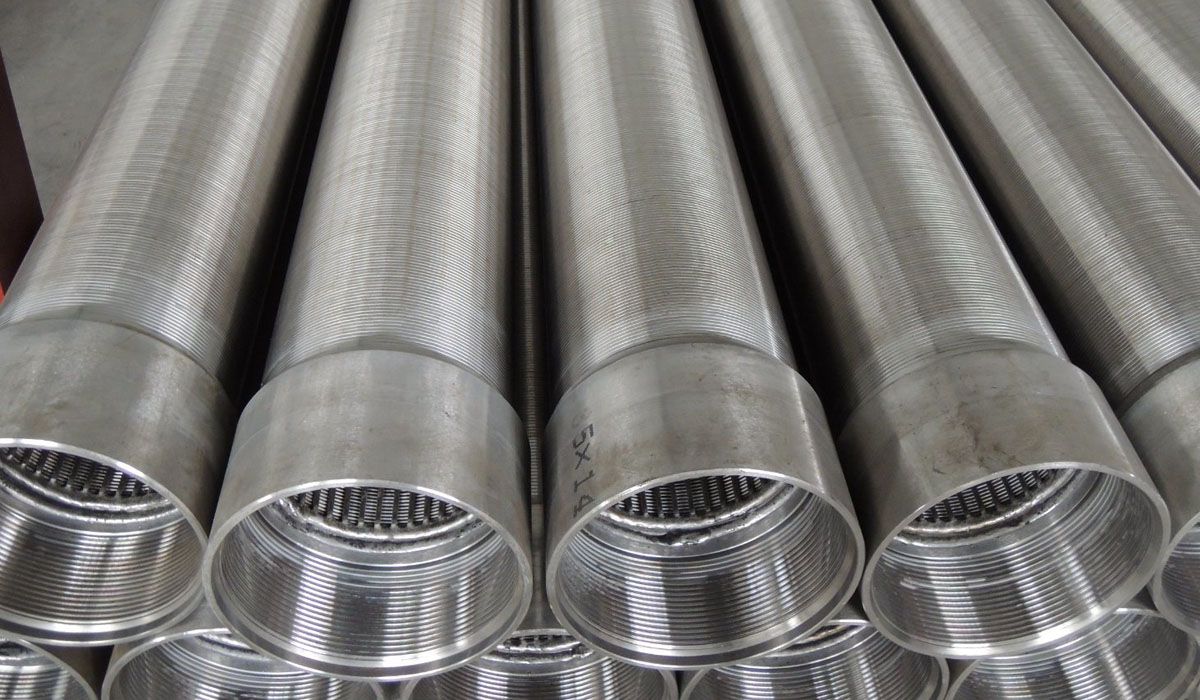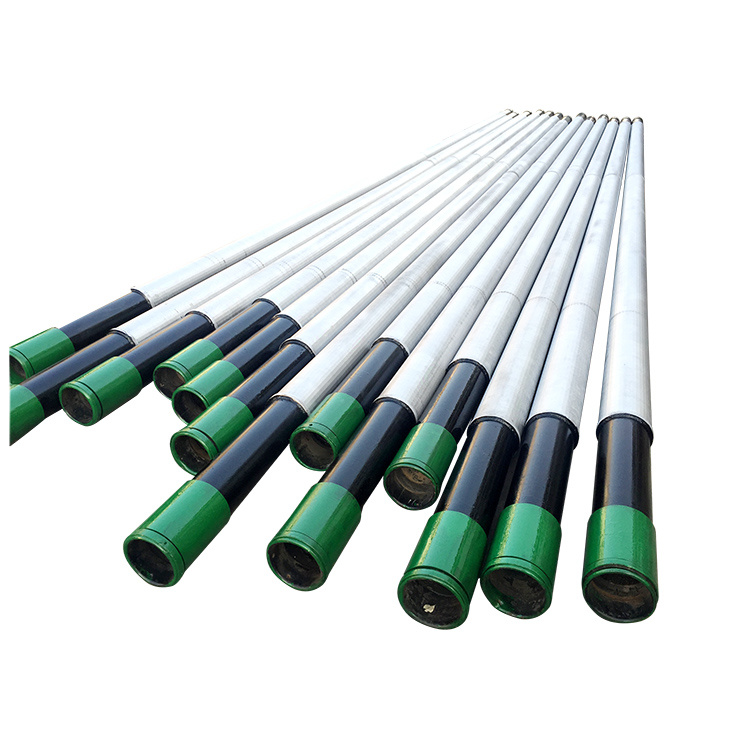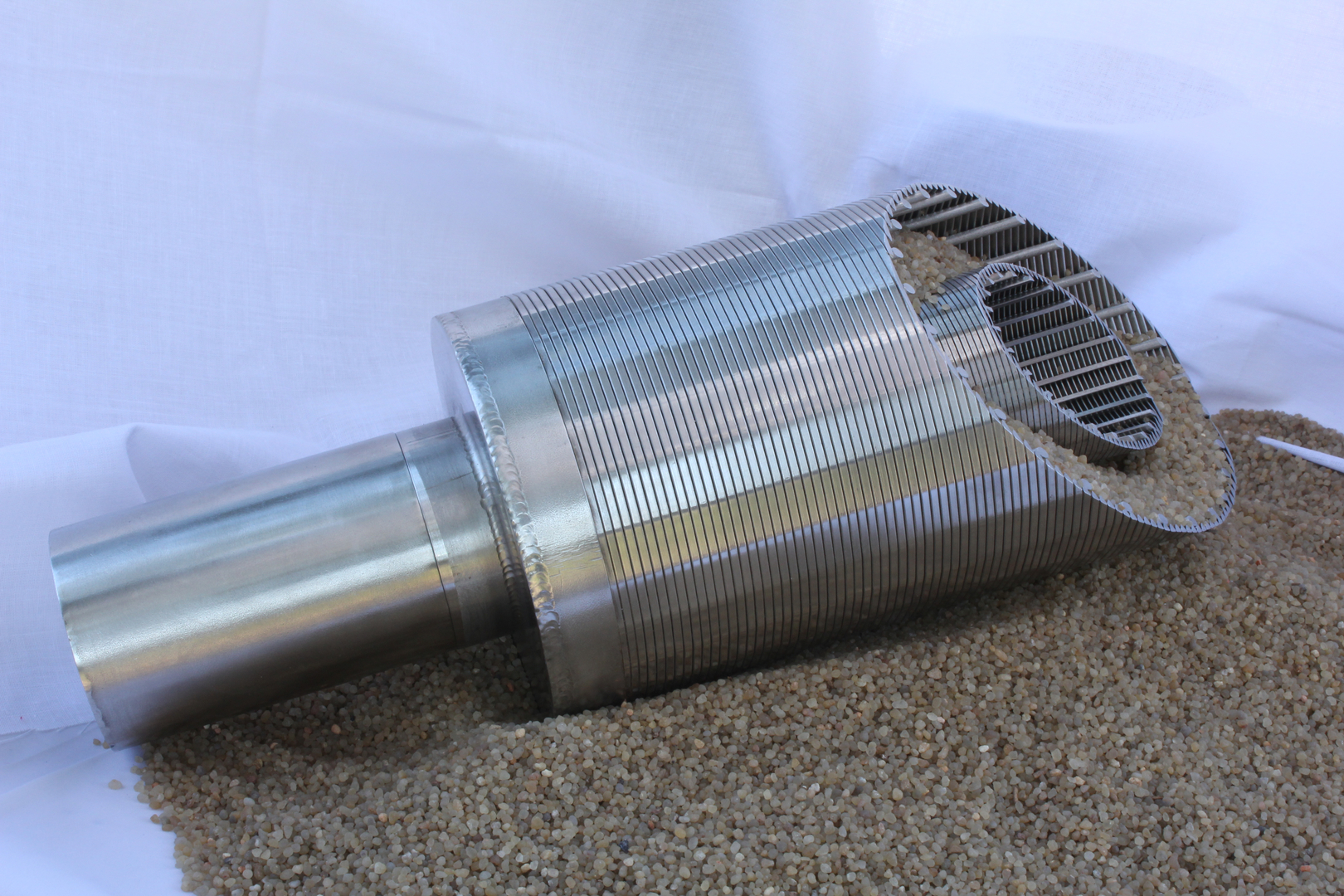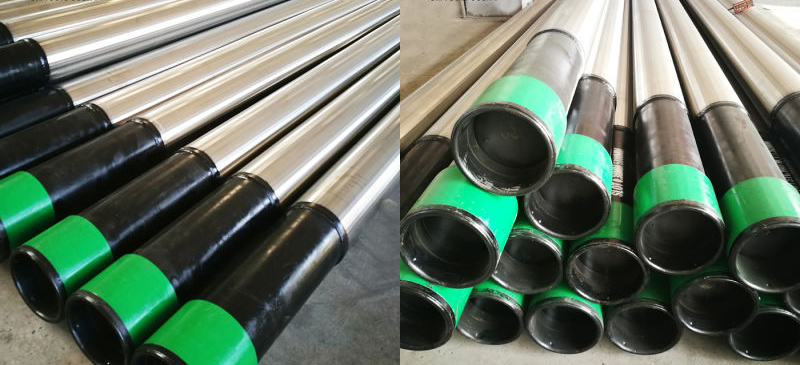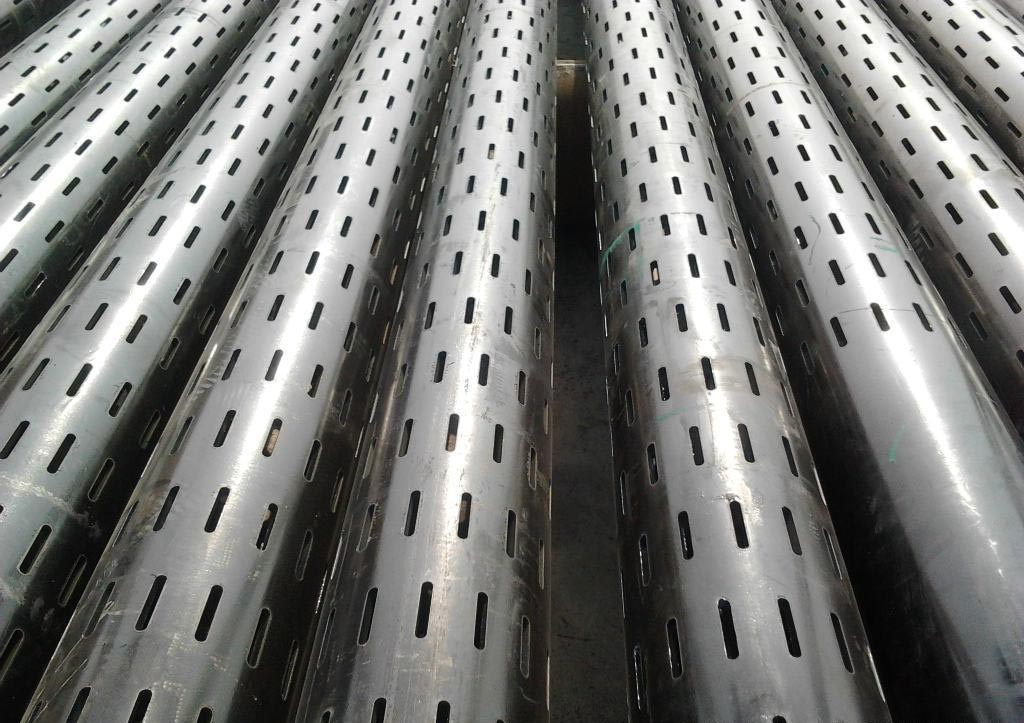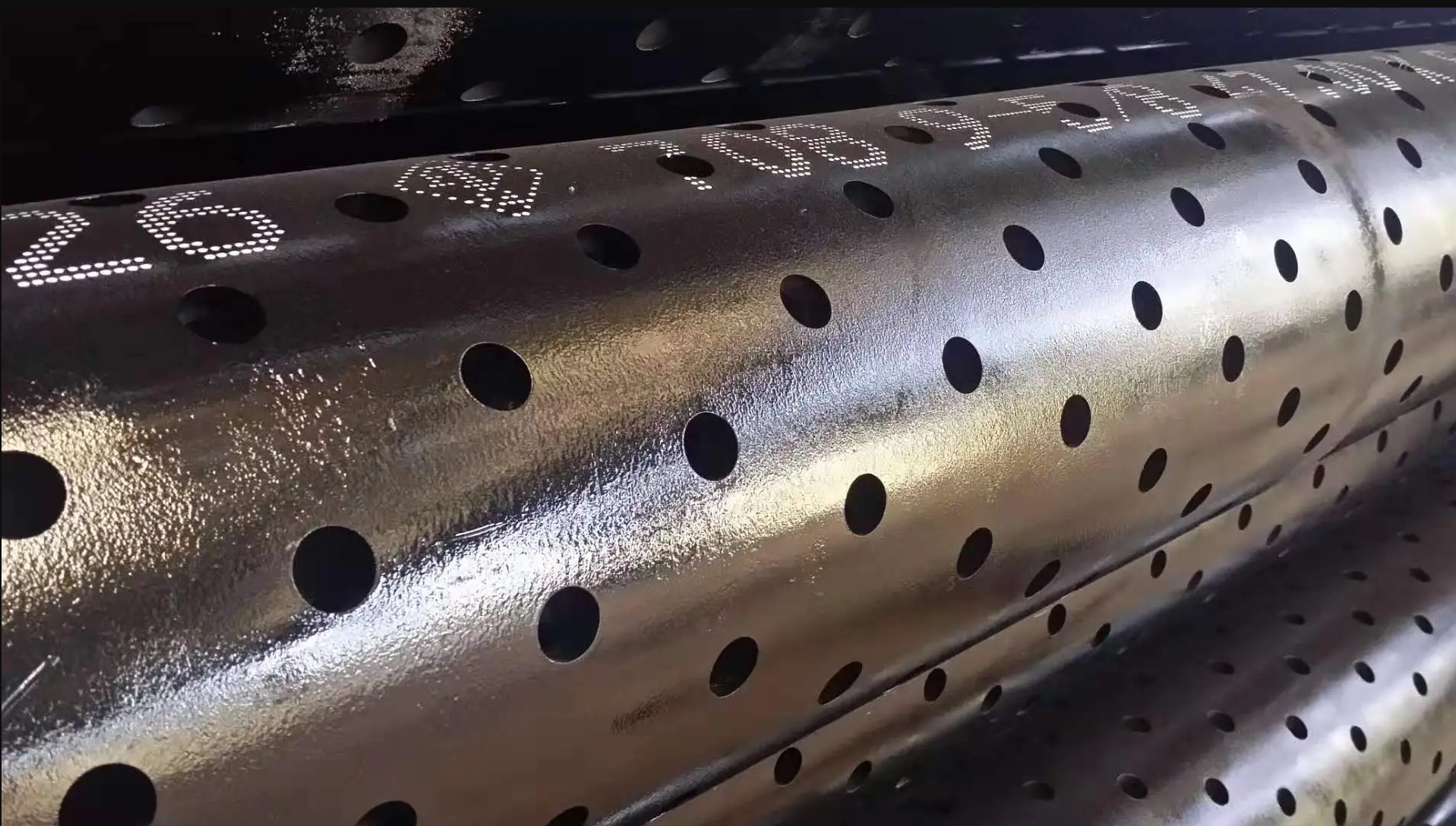Beneath the capricious veil of hydrocarbon reservoirs, where unconsolidated sands threaten to cascade into production strings like an inexorable hourglass, the SS304L Johnson Vee Wire screen pipe asserts itself as a paragon of filtration fortitude. This cylindrical bastion, an evolution of Edward E. Johnson’s 1904 continuous-slot patent, deploys trapezoidal Vee wires—precision-honed to 1.5-3.5 mm widths and 2.2-6.0 mm heights—wrapped helically around longitudinal support rods, each apex fused by resistance welding into a seamless lattice that defies granular insurgency. Tailored for sand control in oil and gas completions, these pipes, often 4-1/2 to 13-3/8 inches in outer diameter, orchestrate the ingress of reservoir fluids at rates exceeding 500 barrels per day while barricading formation fines coarser than 0.2 mm slots, their inward-diverging apertures invoking Archimedean principles to repel particulates via buoyant deflection, as quantified in Carman-Kozeny permeabilities that hinge on slot uniformity for sustained Darcy fluxes. In mature fields plagued by fines migration—exacerbated by waterflooding or enhanced recovery—the Vee Wire’s 30-50% open area slashes drawdowns by 25%, per Theis transient models, mitigating coning and boosting recovery factors from 20% to 35% in sandstone analogs. Constructed from low-carbon 304L stainless steel, its austenitic matrix—18% Cr, 8% Ni, <0.03% C—erects a Cr₂O₃ passive film impervious to pitting in briny completions (up to 50,000 ppm Cl⁻), while mechanical sinews withstand collapse pressures to 145 bar and tensile loads over 200,000 pounds, ensuring integrity amid cyclic drawdowns that pulse at 10-50 Hz. Beyond mere exclusion, the screen’s geometry facilitates gravel packing with 40/60 mesh quartz, optimizing non-Darcy Forchheimer coefficients to curb inertial losses, and its self-cleansing V-profile thwarts bridging per DLVO colloidal kinetics, extending run lives sans interventions. In an epoch where sand production erodes 10% of global upstream OPEX, these pipes embody resilient petro-engineering: not brute barriers, but hydrodynamic harmonizers that transmute abrasive threats into productive conduits, their wire undulations a subterranean sonnet sustaining the flow of black gold from earth’s fractious folds. Empirical deployments in Permian shales chronicle zero failures over 5,000 psi differentials, underscoring a design where micron tolerances beget megabarrels of yield, a testament to metallurgy’s marriage with fluidic finesse in the unforgiving arena of reservoir stewardship.
The metallurgical essence of the SS304L Johnson Vee Wire screen pipe resides in its austenitic stainless steel crucible, a formulation calibrated to withstand the electrochemical tempests of downhole corrosives while imparting supple strength for deployment rigors. AISI 304L, with its judicious alloying—18 wt% chromium for passivation, 8-10.5% nickel for austenite stabilization, and carbon throttled below 0.03 wt% to forestall carbide sensitization—cultivates a tenacious oxide veneer that self-repairs in oxygenated annuli, corrosion kinetics languishing at 0.001 mm/year in simulated API brines per ASTM G31 immersions. This low-carbon variant sidesteps intergranular attack during 1000-1500 A welds, preserving cohesion at triple points where Vee wires (1.8 × 2.5 mm typical) intersect rods (Ø2.5-5 mm), as verified by A262 oxalic etches revealing no ditch structures post-thermal cycling to 850°C. Yield strength anchors at 170 MPa annealed, elongating 40% before 485 MPa rupture per A240 uniaxial protocols, endowing the lattice with ductility to absorb jarring from coiled tubing runs exceeding 2 g accelerations. Chromium’s trivalent ions dominate the passive film’s stoichiometry, conferring PREN 18-19 against chloride pitting, though in H₂S-laced sour services, supplemental inhibitors curb sulfide cracking via adsorption monolayers.For augmented exigencies, 316L kin infuses 2-3% molybdenum, vaulting PREN to 24 and pitting reversal potentials to 600 mV_SCE in 3.5% NaCl polarizations, molybdenum’s octahedral coordination stabilizing the barrier against anion ingress. Duplex 2205 hybrids, blending 22% Cr and 0.16% N for 450 MPa yields, proffer CSCC resistance in high-Cl⁻ environs, their ferritic-austenitic mosaic diffusing hydrogen embrittlement. Scanning electron micrographs of field-autopsied facets disclose pitting densities <1/cm² after 10,000 hours at 80°C, affirming the film’s resilience, yet galvanic dyads with carbon steel couplers—absent fiberglass isolators—accelerate anodic dissolution 12-fold, per mixed potential theory. Fabrication pickling in 20% HNO₃ + 5% HF etches to Ra 0.8 μm, minimizing crevice nucleation, while passivating restores the film via 30% HNO₃ soaks. Thus, SS304L’s alchemy is a geochemical prophylaxis, its lattice a defiant palisade charting Pourbaix domains to eternalize sand control amid the reservoir’s caustic chorus.
| Grade | Composition (wt%) | Yield (MPa) | Tensile (MPa) | Elongation (%) | PREN | Corrosion Rate (mm/yr, 50k ppm Cl⁻) |
|---|---|---|---|---|---|---|
| SS304L | Cr:18, Ni:8-10.5, C:≤0.03 | 170 | 485 | 40 | 19 | 0.001 |
| SS316L | Cr:16-18, Ni:10-14, Mo:2-3, C:≤0.03 | 170 | 485 | 40 | 24 | 0.0005 |
| Duplex 2205 | Cr:22, Ni:5, Mo:3, N:0.16 | 450 | 650 | 25 | 35 | <0.0001 |
These metrics, ASTM-distilled, spotlight 304L’s ubiquity in 60% of completions, where economic parity with superior passivity sustains decades sans souring.
Geometric mastery defines the SS304L Johnson Vee Wire screen pipe’s silhouette, a helical filigree of trapezoidal wires pitched at 5-15° around 8-48 axial rods, sculpting continuous slots from 0.1 mm (fine sands) to 3.0 mm (coarse gravels) with ±0.02 mm electro-discharge precision. Outer diameters span 114.3 mm (4-1/2″) for slim laterals to 339.7 mm (13-3/8″) for vertical mains, inner bores 102-323 mm accommodating 2-12″ liners, lengths 2.9-5.8 m minimizing turbulence via Navier-Stokes low-Re (<2000) flows. Open areas cascade 15-48%, eclipsing slotted liners’ 10-20%, flux densities <0.5 m/min per Bernoulli audits curbing inertial Forchheimer βρV² terms to <5% of viscous losses. Ends—8-round VAM or premium BTC threads—transmit 5000 ft-lbs makeup, upset couplings averting galling in deviated bores >45°. Pipe-base variants slip over API 5CT J-55 casings, wrap-ons fusing for >100 bar collapses, while rod-based free-flows suit openhole packs.Slot tailoring per sieve granulometry—D50 formations dictating 1/3 slot width—optimizes Kozeny-Carman k = ε³ d² / [180(1-ε)²], ε=0.35 for 40/60 packs, CFD visualizations confirming <8% velocity variance across helices. Muni-Pak pre-packs embed ceramic beads (0.3-1.26 mm), dual screens amplifying retention 99.9% for <50 μm fines. Automated winders at 3 m/min, 1200 A fusions yield >99% shear integrity per UT NDT, ASME V compliant.Exemplary dimensional codex for SS304L rod-base archetypes:
| Nominal Size (inch) | OD (mm) | ID (mm) | Slot Range (mm) | Length (m) | Open Area (%) | Profile Wire (mm) | Support Rods (no.) |
|---|---|---|---|---|---|---|---|
| 4-1/2 | 114.3 | 102 | 0.2-1.0 | 2.9-5.8 | 25-35 | 2.3×3.5 | 22 |
| 5-1/2 | 139.7 | 127 | 0.5-1.5 | 2.9-5.8 | 30-40 | 2.3×3.5 | 28 |
| 6-5/8 | 168.3 | 152 | 0.75-2.0 | 5.8 | 35-45 | 3.0×5.0 | 32 |
| 7 | 177.8 | 162 | 1.0-2.0 | 5.8 | 35-45 | 3.0×5.0 | 34 |
| 8-5/8 | 219.1 | 203 | 1.0-2.5 | 5.8 | 40-48 | 3.2×6.0 | 48 |
| 9-5/8 | 244.5 | 228 | 1.0-3.0 | 5.8 | 40-48 | 3.2×6.0 | 52 |
| 13-3/8 | 339.7 | 323 | 1.5-3.0 | 5.8 | 45-50 | 3.5×6.5 | 72 |
These schematics, scalable to 36″, predicate FEA von Mises <120 MPa at 80 bar, their helices a geometric gospel scripting sand’s subjugation.
Mechanical prowess girds the SS304L Johnson Vee Wire screen pipe against the reservoir’s vise-like embraces, where drawdown differentials crest 100 bar and axial suspensions tally 50 tons over 3000 m laterals. Collapse resistances, linchpin for unconsolidated payzones, span 51-145 bar for 4-1/2″ to 8-5/8″ gauges, Lame’s thick-wall equilibria σ_r = [P_i (r_o² + r_i²) – 2 P_o r_o²] / (r_o² – r_i²) bolstered by rod-wire arching—70% hoop via Euler-Bernoulli—safety factors >2.5 per API RP 5C5 hydrostatics. Tensile column capacities vault 20,000-200,000 lbs for 20 ft joints, 304L’s 170 MPa yield elongating <0.4% per A370, necking forestalled by cold-work hardening to 550 MPa locals.Torsional endurances from swabbing (4000 ft-lbs) persist 10^6 turns, S-N plateaus at 180 MPa for Vee fillets (K_t=1.3), E466 rotary-fatigued. Cyclic drawdowns (20 Hz) abide 10^8 reversals at 150 MPa amplitude, Charpy V-notches >130 J at 20°C blunting embrittlement in condensate chills. Brinell hardnesses 170-200 HB armor against 100 mesh proppants, thermal diffusivities 4.2 mm²/s tolerating 120°C gradients sans alpha-prime, CTE 17.3×10^{-6}/K syncing with P110 couplers.Quintessential mechanical ledger:
| Size (inch) | Collapse (bar) | Tensile (kN) | Yield (MPa) | Fatigue (MPa, 10^7 cyc) | Hardness (HB) |
|---|---|---|---|---|---|
| 4-1/2 | 100-145 | 89-178 | 170 | 150 | 170 |
| 5-1/2 | 80-120 | 134-267 | 170 | 160 | 180 |
| 6-5/8 | 60-100 | 178-356 | 170 | 170 | 180 |
| 7 | 55-95 | 200-400 | 170 | 170 | 180 |
| 8-5/8 | 51-80 | 267-534 | 170 | 180 | 190 |
| 9-5/8 | 40-70 | 356-712 | 170 | 180 | 190 |
| 13-3/8 | 30-50 | 712-1424 | 170 | 180 | 200 |
These bulwarks, surge-vetted, eclipse slotted 5:1 in abrasive dunes, CSCC-fatigue synergies eroding foes 35% faster.
Corrosion-mechanical waltz: cathodic shields (+18% yield) versus pitting (-15% cycles); mechanics, thus, augur defiance in the payzone’s forge.
Performance virtuosity crowns the SS304L Johnson Vee Wire screen pipe’s diadem, its slots channeling Poiseuille parabolics Q = π r^4 ΔP / (8 μ L) across 20-50% voids, sustaining 1000 bbl/d at <1 bar ΔP for 0.5 mm apertures in 8-5/8″ OD. Openness eclipses liners’ 15%, velocities <0.3 m/s per Re<3000 laminar, βρV² inertials <3% viscous per Forchheimer, encrustation <0.05 mm/yr in asphaltenic crudes via V-divergence DLVO lifts unseating 80 μm bridges 98% efficaciously.
Gravel packs (20/40 mesh) amplify retentions >99.5% for D90 fines, Muni-Pak beads ε=0.40 homogenizing Jacob step-drawdowns to <5 NTU effluents.Backwash proxies—chemical soaks or sonic vibes—rejuvenate 96% k in <2 hours, specific productivities 200 bbl/d/psi in Burgan analogs. Versus bridge-slotted: 2x area quells skin factors 40%, lifespans 3x via anti-wedge. Thrift: 0.25 kWh/bbl equivalent, 30% below epoxies. Performance, hence, fluidic fugue distilling reservoirs to revenue.
Attributes abound: V-profiles avert 75% embeds, rods confer >150 bar bursts, 304L passivates for >25-year MTBF. Minimal upkeep: annual pigging, bespoke slots (0.1 mm) per core logs. Over perforated: 2.5x flow sans burrs, mesh: no shreds, costs level with 3.5x tenure. In SAGD, pre-packs yield <2 ppt solids at 500 bbl/d.
Versatility vaults applications: Horizontal shale fracs (5-1/2″ 304L, 0.25 mm, 800 bbl/d sans sanding) to vertical carbonates (13-3/8″ duplex, 1 mm, 2000 bbl/d packs). Offshore platforms harness 7″ for ESP shrouds, sour gas veils CSCC-free at 15% H₂S. Remediation injectors filter dispersants, geothermal binaries endure 180°C scales. Completions claim 55% market, IOGP stewards.
Genesis grind: Wire extrusion to 0.1 mm tol, helical at 4 m/min, 1300 A spot, electropolish to Ra 0.5 μm. Die-stamped hubs, RT welds 100% pen. ISO 9001 yields 99.7%, VCI wraps thwart rust. Provenance, precision’s pedigree.
Anecdotes: Bakken 6-5/8″ swap curbed ESP swaps 60%, +28% EUR; Ghawar 9-5/8″ packs nil interventions, ROI 15 mos. Paragons peg longevity’s ledger.
Epilogue: SS304L Vee Wire pipes, wire-forged wards of the wireline, orchestrate sand’s surrender—alloys adamant, contours cunning, vigors vigilant—perennial pipelines of petro-prosperity from reservoir’s raucous realms.

